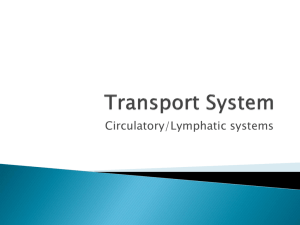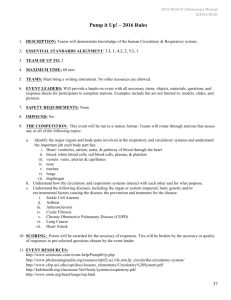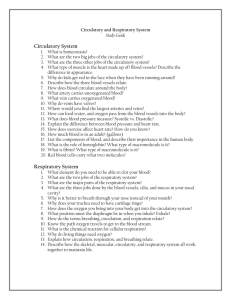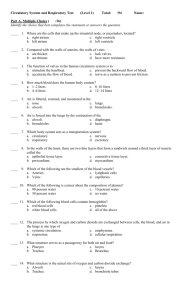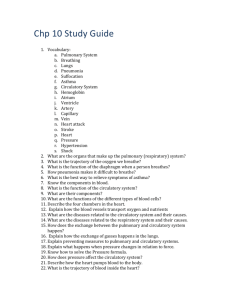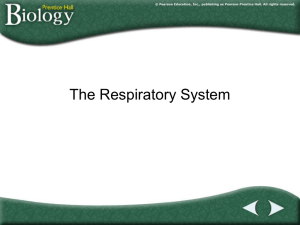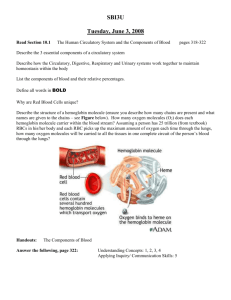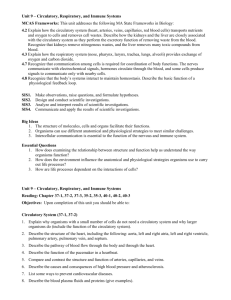chapter 37.1-2 blood and lymph
advertisement
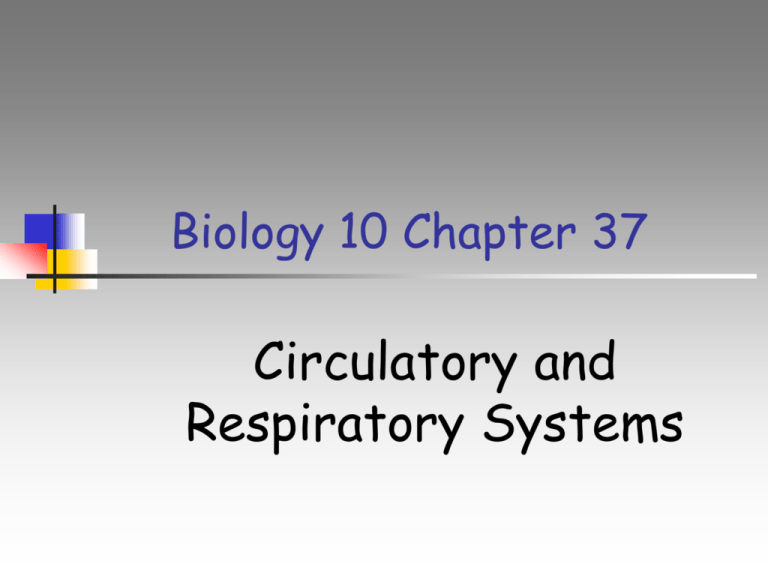
Biology 10 Chapter 37 Circulatory and Respiratory Systems 37-1 The Circulatory System Organisms composed of a small number of cells do not need a circulatory system - oxygen and nutrients can diffuse across cell membranes Larger organisms cannot rely on diffusion - they need a circulatory system 37-1 The Circulatory System The human circulatory system consists of the heart, a series of blood vessels, and the blood that flows through them. The Heart - composed almost entirely of muscle - about the size of a fist - enclosed in a protective sac of tissue called a pericardium 37-1 The Circulatory System - inside the walls of the heart is a thick layer of muscle called the myocardium - contractions pump blood through the circulatory system - the heart contracts about 72 times a minute, pumping about 70 ml of blood with each contraction 37-1 The Circulatory System - the septum is a wall that divides the right side of the heart from the left side - prevents the mixing of oxygenpoor and oxygen-rich blood - on each side of the septum are two chambers - the atrium is the upper chamber and receives the blood 37-1 The Circulatory System - the ventricle (the lower chamber) pumps blood out of the heart Heart animation Circulation through the body - pulmonary circulation: the right side of the heart pumps blood from the heart to the lungs - systemic circulation: the left side of the heart pumps blood to the body 37-1 The Circulatory System 37-1 The Circulatory System Capillaries of head and arms Superior vena cava Pulmonary vein Capillaries of right lung Aorta Pulmonary artery Capillaries of left lung Inferior vena cava Capillaries of abdominal organs and legs 37-1 The Circulatory System Blood flow through the heart - blood enters through an atria - as the heart contracts, blood flows into the ventricles, and then out - valves: flaps of connective tissue between the atria and ventricles that keep blood flowing in one direction Blood flow movie 37-1 The Circulatory System Heartbeat - each contraction begins in a small group of muscle cells in the right atria - cells are called the sinoatrial node (SA node) or pacemaker - when the atria contracts, blood flows into the ventricles; when the ventricles contract, blood exits the heart 37-1 The Circulatory System Sinoatrial (SA) node Conducting fibers 37-1 The Circulatory System Conducting fibers Atrioventricular (AV) node 37-1 The Circulatory System Blood Vessels - aorta: large vessel that blood leaves the heart from to transport oxygen to the body As blood flows through the circulatory system, it moves through three types of blood vessels- arteries, capillaries, and veins 37-1 The Circulatory System - arteries: large vessels that carry blood from the heart to the tissues of the body - capillaries: smallest blood vessels; they have thin walls that allow for the transport of nutrients, gasses, and wastes 37-1 The Circulatory System - veins: blood vessels that returns deoxygenated blood to the heart; contain one-way valves Blood pressure - measures the force of the blood on the arteries - two numbers (systolic and diastolic pressures); 120/80 37-1 The Circulatory System Vein Artery Endothelium Arteriole Capillary Venule Connective tissue Connective tissue Smooth muscle Endothelium Smooth muscle Endothelium Valve 37-1 The Circulatory System 37-1 The Circulatory System 37-1 The Circulatory System Disorders of the circulatory system atherosclerosis: when fatty deposits called plaques build on the walls of arteries - obstruct the flow of blood High blood pressure - forces the heart to work harder; may cause a heart attack or stroke 37-1 The Circulatory System 37-1 The Circulatory System Heart attack - if arteries become blocked, part of the heart may die from a lack of oxygen Stroke - blood clots get stuck in the blood vessels leading to parts of the brain; also caused by an artery bursting in the brain Section Quiz The layer of muscle in the heart that pumps blood through the circulatory system is called the myocardium. atrium. ventricle. vena cava. Section Quiz Oxygen-poor blood from the body enters the heart through the left atrium. left ventricle. right atrium. right ventricle. Section Quiz Atherosclerosis is a condition in which blood cells die from a lack of oxygen. plaque builds up along the walls of the arteries. blood pressure is too high. the heart stops pumping blood. Section Quiz The vein that brings oxygen-poor blood from the upper part of the body to the right atrium is the pulmonary vein inferior vena cava. aorta superior vena cava. 37-2 Blood and the Lymphatic System Blood - connective tissue that contains both dissolved substances and specialized cells - collects oxygen from the lungs, nutrients from the digestive tract, and waste products from tissues 37-2 Blood and the Lymphatic System The human body contains 4 to 6 liters of blood - 45% are cells - 55% is blood plasma Plasma is about 90% water and 10% gases, salts, nutrients, and plasma proteins 37-2 Blood and the Lymphatic System Plasma proteins are divided into three groups: albumins, globulins, and fibrinogen - albumins and globulins transport substances - fibrinogen clots blood 37-2 Blood and the Lymphatic System Plasma Platelets White blood cells Red blood cell Whole Blood Sample Sample Placed in Centrifuge Blood Sample That Has Been Centrifuged 37-2 Blood and the Lymphatic System Blood cells The cellular portion of blood consists of red blood cells, white blood cells, and platelets Red Blood Cells (RBC) - also called erythrocytes - transport oxygen through the body 37-2 Blood and the Lymphatic System - hemoglobin is the iron-containing protein that binds to oxygen; make cells red - RBC are produced in the red bone marrow - live around 4 months (120 days) 37-2 Blood and the Lymphatic System 37-2 Blood and the Lymphatic System White blood cells (WBC) - also called leukocytes - attack foreign substances or organisms - can live for several months - phagocytes engulf and digest foreign cells 37-2 Blood and the Lymphatic System Platelets Blood clotting is made possible by plasma proteins and cell fragments called platelets - platelets contact blood vessels; their surfaces become sticky; several group around a wound 37-2 Blood and the Lymphatic System Break in Capillary Wall Clumping of Platelets Clot Forms Blood vessels injured. Platelets clump at the site and release thromboplastin. Thromboplastin converts prothrombin into thrombin.. Thrombin converts fibrinogen into fibrin, which causes a clot. The clot prevents further loss of blood.. 37-2 Blood and the Lymphatic System 37-2 Blood and the Lymphatic System Lymphatic system A network of vessels called the lymphatic system collects the fluid that is lost by the blood and returns it to the circulatory system Lymph: fluid that collects in capillaries and flows to larger vessels 37-2 Blood and the Lymphatic System Section Quiz The plasma protein that responsible for blood clotting is albumin. fibrinogen. globulin. hemoglobin. Section Quiz White blood cells that engulf and digest foreign cells are known as phagocytes. platelets. antibodies. thrombocytes. Section Quiz Blood cells that do not have nuclei and are produced by the red bone marrow are red blood cells. lymphocytes. platelets. phagocytes. Section Quiz The function of platelets is to assist red blood cells in carrying oxygen. destroy viruses and bacteria. initiate the blood clotting process. keep capillaries open so blood can flow freely through. Section Quiz The function of lymph nodes is to trap bacteria and viruses that cause disease. produce antibodies. manufacture new red and white blood cells. store fat. 37-3The Respiratory System “Respiration” is used in biology in two different ways. - cellular respiration: the release of energy from food w/ oxygen; makes ATP - respiration: the process of exchanging oxygen and carbon dioxide 37-3The Respiratory System The job of the respiratory system is to exchange oxygen and carbon dioxide. The respiratory system consists of the nose, pharynx, larynx, trachea, bronchi, and lungs Respiration movie 37-3The Respiratory System Nose Pharynx Larynx Mouth Trachea Lungs Bronchus Epiglottis Bronchioles Diaphragm 37-3The Respiratory System Pathway of air - air moves through the nose to a tube at the back of the mouth called the pharynx, or throat - serves as a passageway for air and food - air moves from the pharynx to the trachea, or windpipe 37-3The Respiratory System - air passes larynx which contains the vocal chords - air passes through the trachea into two passageways called bronchi - each bronchus leads to a lung - the bronchi branch into bronchioles 37-3The Respiratory System - the bronchioles subdivide until they reach millions of tiny air sacs called alveoli - alveoli are clustered into groups that resemble bunches of grapes - the alveoli are the location of gas exchange 37-3The Respiratory System Alveoli Bronchiole 37-3The Respiratory System 37-3The Respiratory System 37-3The Respiratory System Gas Exchange - oxygen dissolves on the surface of the alveoli and then diffuses across capillaries into the blood - carbon dioxide diffuses in the opposite direction 37-3The Respiratory System O2 Capillary 37-3The Respiratory System O2 CO2 Capillary 37-3The Respiratory System Breathing - the lungs are located inside the chest cavity. At the bottom of the cavity is the diaphragm - when you inhale, the diaphragm contracts - when you exhale, the diaphragm relaxes Breathing animation 37-3The Respiratory System Air exhaled Air inhaled Rib cage descends Rib cage rises Diaphragm Diaphragm Inhalation Exhalation Section Quiz Air passes through the trachea into two large passageways in the chest cavity known as the bronchi. alveoli. epiglottis. bronchioles. Section Quiz The function of the cilia lining the respiratory surfaces is to improve the amount of oxygen and carbon dioxide exchanged in the lungs. cover the opening of the trachea when you swallow. move air in and out of the lungs. sweep trapped particles and mucus away from the lungs. Section Quiz Oxygen diffuses from the alveolus into the blood because blood entering the capillaries of the lungs is oxygenpoor. blood entering the capillaries of the lungs is oxygenrich. air entering the lungs has more carbon dioxide than oxygen. air entering the lungs has less oxygen than is found in the blood.
